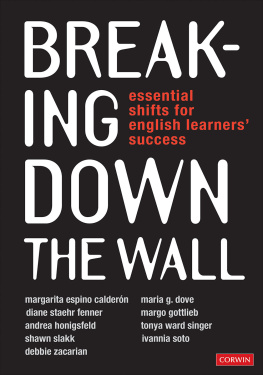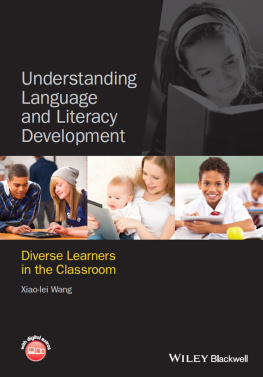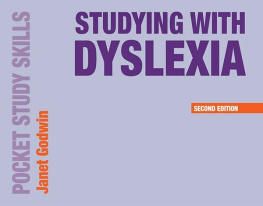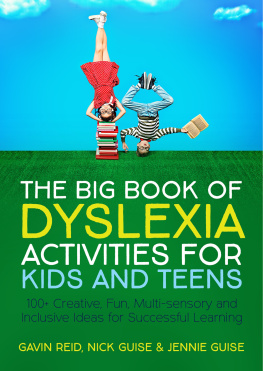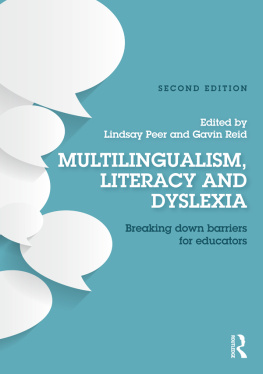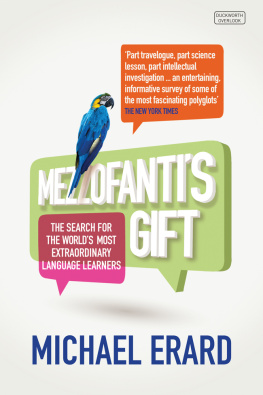The context
It is now over 15 years since we edited the first edition of this book. At that time it was very much a landmark book and we attempted to incorporate contributions from a diverse range of cultures and languages. The book followed the first international conference on multilingualism which was held at UMIST in Manchester in England in 1999 and organized by the British Dyslexia Association (BDA). It was by all accounts a well-attended and very successful event. Lindsay Peer, the education director of the BDA at that time, liaised with the International Dyslexia Association CEO J. Thomas Viall who secured the boards support for the event.
A follow-up conference was held in Washington DC in the USA several years later, organized by the International Dyslexia Association (IDA) and arranged through the efforts of one of the board members, Dr Charles Haynes.
The European Dyslexia Association (EDA) ran the third in the series of three conferences as was originally agreed. Since then the EDA have arranged a series of European conferences which by the very nature of a larger and diverse Europe have focused on issues relating to multilingualism and this has contributed to taking the debate forward. Additionally there have been a number of high-profile European projects through Erasmus and Socrates European funding that have witnessed many European countries entering this area for the first time.
The European collaboration is a significant step in preparing and implementing diagnostic and intervention strategies to cater for the diverse needs of students who are utilizing more than one language within the family, education and community context. The area of teacher training has also been highlighted and there is currently a high-profile three-year Erasmus ). Despite these initiatives there is still much to be accomplished and further constructive government initiatives and support are needed at local, national and international level.
It is however recognized that dealing with dyslexia and issues relating to bi/multilingualism is a significant concern, particularly in the current climate, for example of free movement within Europe and the migration of large populations to western Europe, but also the ongoing migration taking place on the world stage in Asia, Australasia and North America. For that reason we have contributions for this book from these areas: Angela Fawcett from Singapore, Sonja MacFarlane and colleagues from New Zealand and Linda Siegel from Canada. These very positive contributions add to the debate and present messages that can be taken on board by all countries.
The key issues are therefore identification of dyslexia, accessing culturally and linguistically appropriate resources, and acknowledging the educational and social needs of all children who are operating in more than one language and culture. It is important to ensure that they are able to fully access the curriculum and that they feel included within the school community.
Overview of the book
It is appropriate to start this book with the chapter by Professor Angela Fawcett on the link between theory and practice in relation to the learning process for young people with dyslexia. Angela relates the research studies carried out by her and colleagues looking at procedural learning and the crucial point that children with dyslexia need specialized teaching to achieve mastery. Of particular interest is the debate which centres round the benefits of bilingualism and that bilingual speakers may have advantages when learning to read. Angela also refers to the Strand Report (Strand et al ., 2015) which identifies Special Educational Needs (SEN) as the major risk factor for English as an Additional Language (EAL) pupils. Although not all these SEN pupils will have dyslexia, it is acknowledged that dyslexia is the most frequently reported area of need. As Angela points out despite the importance of this topic, there have been relatively few publications on EAL and dyslexia.
Professor Fawcett points out that the success of intervention depends to a certain extent on the transparency of the language and she goes on to discuss that point in her chapter. The nature of the language can therefore be a barrier to success. The issue of barriers to learning is taken further by Lindsay Peer in her chapter on otitis media (glue ear). As Dr Peer indicates, little has been done to investigate the impact of otitis media on educational success although this affects so many children in the early years and in all countries. Dr Peer goes on to discuss appropriate interventions and relates these very much to dyslexia and multilingualism.
In thought-provoking section on the construction of dyslexia in multilingualism. She also indicates that drawing on critical pedagogy in professional development can offer a methodology that can raise awareness in primary and secondary schools, and challenge assumptions about multilingualism in relation to classroom/curriculum learning.
This is followed by the chapter by Dr Gad Elbeheri and Professor John Everatt who discuss principles and guidelines in test construction for multilingual children. This is a crucial chapter as it is important that appropriate assessment tools are used to ensure that bilingual children are fairly represented in the population of children who are identified as dyslexic. At present this is not always the case. As the authors concede, multilingualism has been a problem in psycho-educational assessment for quite some time and there is a lack of diagnostic tools that allow practitioners to distinguish between language differences related to the environmental context of growing up as a multilingual immigrant and language impairments of a neuro-linguistic origin.
In their chapter they also refer to the importance of assessing the child in their first language in order to distinguish between an underlying cognitive deficit, as opposed to a lack of second language acquisition leading to poor vocabulary that may be improved simply by increased practice.
They refer to the Arabic context as an example of the importance of robust test construction and particularly the importance of assessing phonological processing skills. They indicate that dyslexia assessment is a dynamic process but, as they suggest, it is important that linguistic, cultural and other background elements of the individual should collectively form a framework for a dyslexia assessment.
This is followed up in by Dr Jennie Guise and colleagues who show how culturally and linguistically appropriate material can be accessed for an accurate assessment. They emphasize the importance of culture-fair assessment but also mention the underrepresentation of dyslexia among the multilingual school population. They also raise the issue of self-esteem crucial for effective learning and the importance of information gathering to ensure the assessment hits the right mark. The importance of assessing non-verbal skills is also raised as well as a range of intervention strategies. In addition, there is reference to a European-wide project spearheaded by Lannen and Lannen on Specific Learning Difficulties (SpLD) teacher training in order to create an EU SpLD website for information and long-distance interactive training.
In we travel to the other side of the world to New Zealand where Dr Sonja Macfarlane, Te Hurinui Clarke and Professor Angus Macfarlane reflect on the contemporary literacy challenges facing Indigenous cultures that draw from oral language traditions. They suggest that the way forward is to engage in a culturally responsive and holistic approach to literacy. They refer particularly to Mori and Pacific learners but their chapter has wider implications and the message is relevant to all countries.


